When Your AC Leaves You Sweating: Understanding the Problem
AC not cooling is one of the most frustrating problems homeowners face during hot summer days. Picture this nightmare: It's hot outside, and you're looking forward to getting home to relax in the cool breeze of the AC. Uh-oh. The AC is not cooling! No matter how long it runs, your home stays warm and uncomfortable.
Most Common Causes of AC Not Cooling:
- Dirty air filter - Blocks airflow and reduces cooling power
- Incorrect thermostat settings - Fan set to "ON" instead of "AUTO"
- Frozen evaporator coils - Ice buildup prevents cold air circulation
- Low refrigerant levels - Often caused by leaks in the system
- Blocked outdoor condenser unit - Debris prevents heat release
- Electrical issues - Tripped breakers or blown fuses
- Faulty compressor - The "heart" of your AC system fails
The good news? Some of these problems have simple DIY fixes you can try before calling a professional. Others require expert diagnosis and repair to get your system running safely again.
A dirty air filter is one of the most common causes of an AC not blowing cold air. When airflow is restricted, your system has to work harder without cooling effectively. This can lead to frozen coils, higher energy bills, and even complete system shutdown.
Before you sweat through another sleepless night, let's walk through the steps to diagnose what's wrong with your AC. We'll start with the easiest checks you can do yourself, then cover when it's time to call in the professionals.
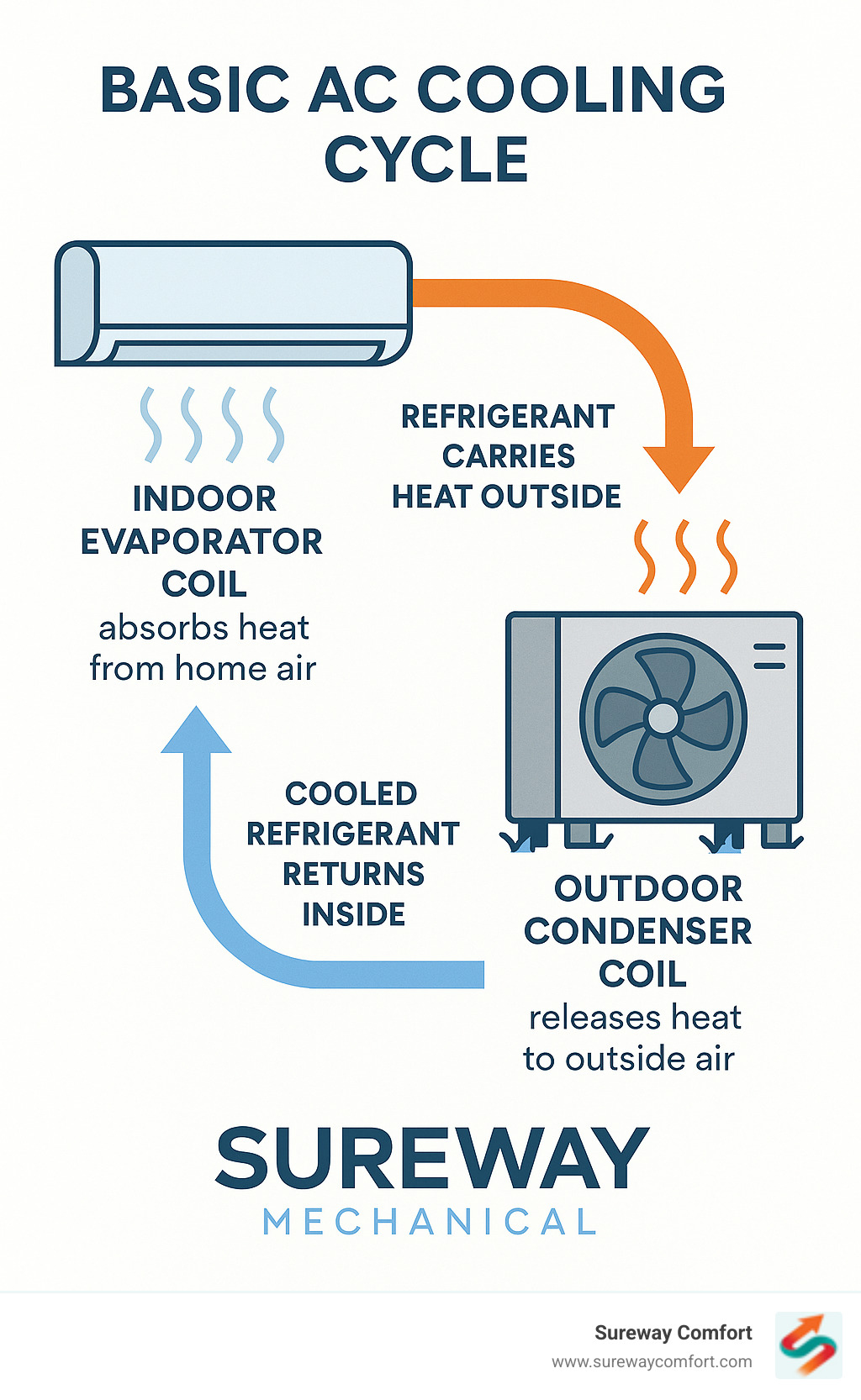
AC not cooling word roundup:
Simple DIY Checks Before You Call for Help
When your AC not cooling turns your home into a furnace, don't panic just yet! Before reaching for your phone to call a technician, there are several quick checks you can do yourself. These simple steps have saved many homeowners both time and money – sometimes the solution is easier than you think.
Check Your Thermostat Settings
It happens to the best of us – sometimes the simplest explanation is the right one. Your thermostat controls everything, so let's make sure it's telling your AC the right thing.
Start by confirming your thermostat is in "Cool" mode. We've seen plenty of cases where someone accidentally switched it to "Heat" or "Fan Only" during cleaning or when changing batteries. Next, check that your temperature setting is actually lower than what your home feels like right now. If it's 80 degrees inside and your thermostat is set to 82, your AC is doing exactly what you told it to do – nothing!
Here's a sneaky culprit: the fan setting. If your fan is set to "ON" instead of "AUTO," it'll keep blowing air even when the cooling isn't running. This means you're getting warm air circulated throughout your house, making it seem like your system is working but not actually cooling anything.
Don't forget to check for dead batteries if your thermostat uses them. A thermostat with dying batteries might not communicate properly with your AC unit. If you're dealing with an older unit, this might be the perfect time to consider upgrading to a smart thermostat, which can help reduce your energy bills while giving you better control.
Inspect the Air Filter for Blockages
Your air filter is like your AC's lungs – when it can't breathe, neither can your cooling system. A clogged filter is hands-down one of the most common reasons we see for an AC not cooling properly.
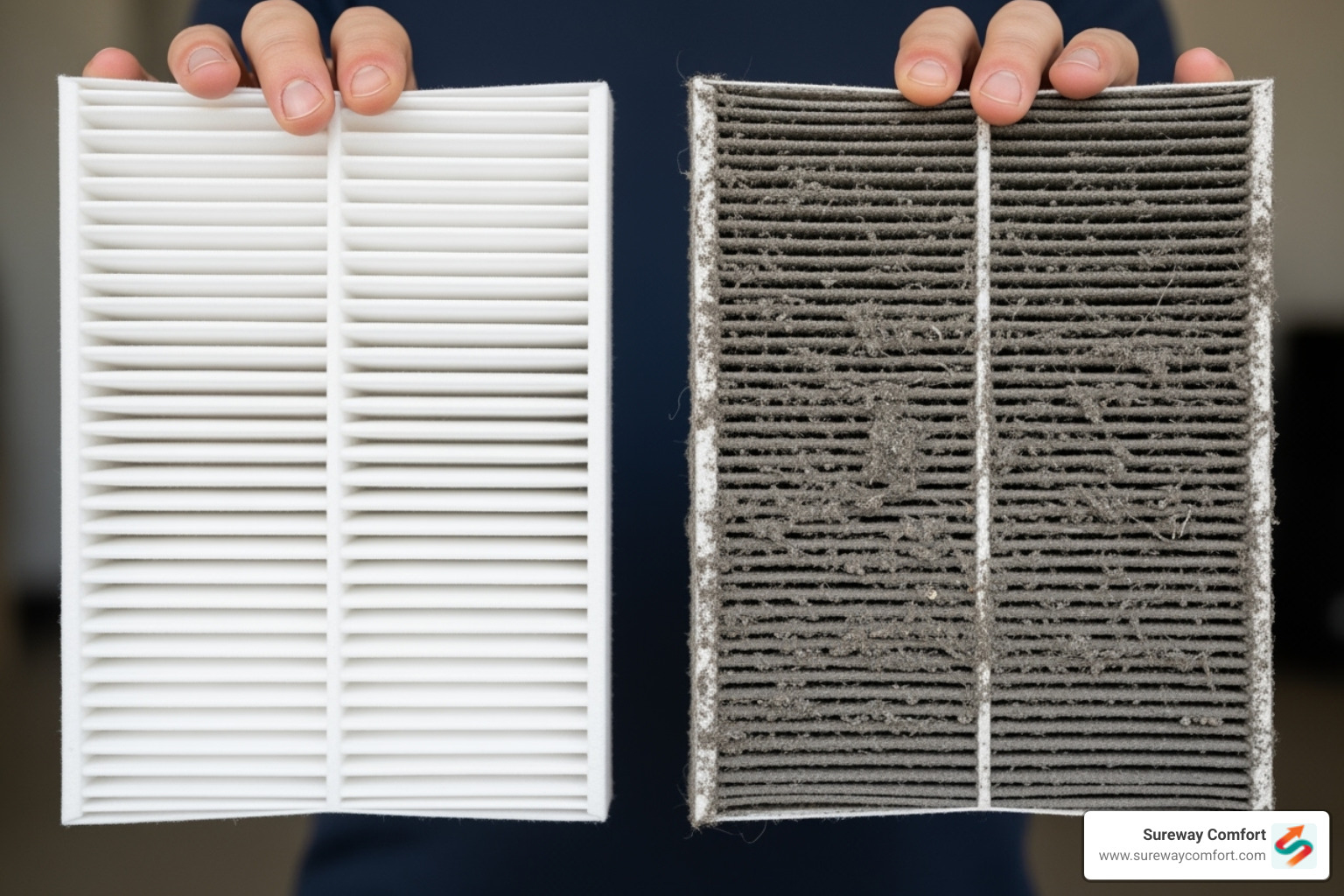
When your filter gets packed with dust, pet hair, and debris, it restricts airflow over your evaporator coils. This means your system can't absorb heat properly, leading to reduced cooling performance and higher energy bills. In worst-case scenarios, this restricted airflow can actually cause your coils to freeze up completely.
How to check your filter: Pull it out and hold it up to a light. If you can't see light passing through, it's definitely time for a replacement. We recommend checking your filter monthly during heavy-use seasons. Most filters need replacing every 1-3 months, though homes with pets or family members with allergies might need more frequent changes.
Look at Your Vents and Breaker Box
Two more quick stops can help solve your cooling mystery: your vents and your electrical panel.
Take a walk through your home and make sure all your vents and registers are open and unobstructed. You'd be surprised how often furniture gets pushed against a vent or curtains block airflow. Kids love to close vents in their rooms too! If cool air can't get out or warm air can't get back to the system, your AC will struggle to cool effectively.
Now head to your circuit breaker box. Sometimes breakers trip due to power surges or temporary overloads, cutting power to your AC entirely. Look for the breaker labeled for your AC unit (some systems have separate breakers for indoor and outdoor units). If you find one in the "OFF" position or sitting in the middle, flip it firmly to "ON."
Important safety note: If the breaker trips again immediately after you reset it, don't keep trying. This signals a more serious electrical problem that needs professional attention. The same goes for blown fuses – these aren't DIY fixes and can be dangerous to handle without proper training.
If these simple checks don't solve your cooling problem, it's time to look deeper into what might be causing your AC troubles.
Common Culprits Behind an AC Not Cooling
If those simple DIY checks didn't solve your cooling crisis, don't worry – you're not alone! Sometimes the problem runs a bit deeper, involving the hardworking components that make your AC system tick. While these issues might sound intimidating, understanding what's happening can help you decide whether it's time to roll up your sleeves or call in the pros.
The three most common culprits we see when an AC not cooling properly are a dirty outdoor condenser unit, frozen evaporator coils, and low refrigerant levels. Each of these problems affects your system's ability to move heat effectively – and that's really what air conditioning is all about: moving heat from inside your home to the great outdoors.
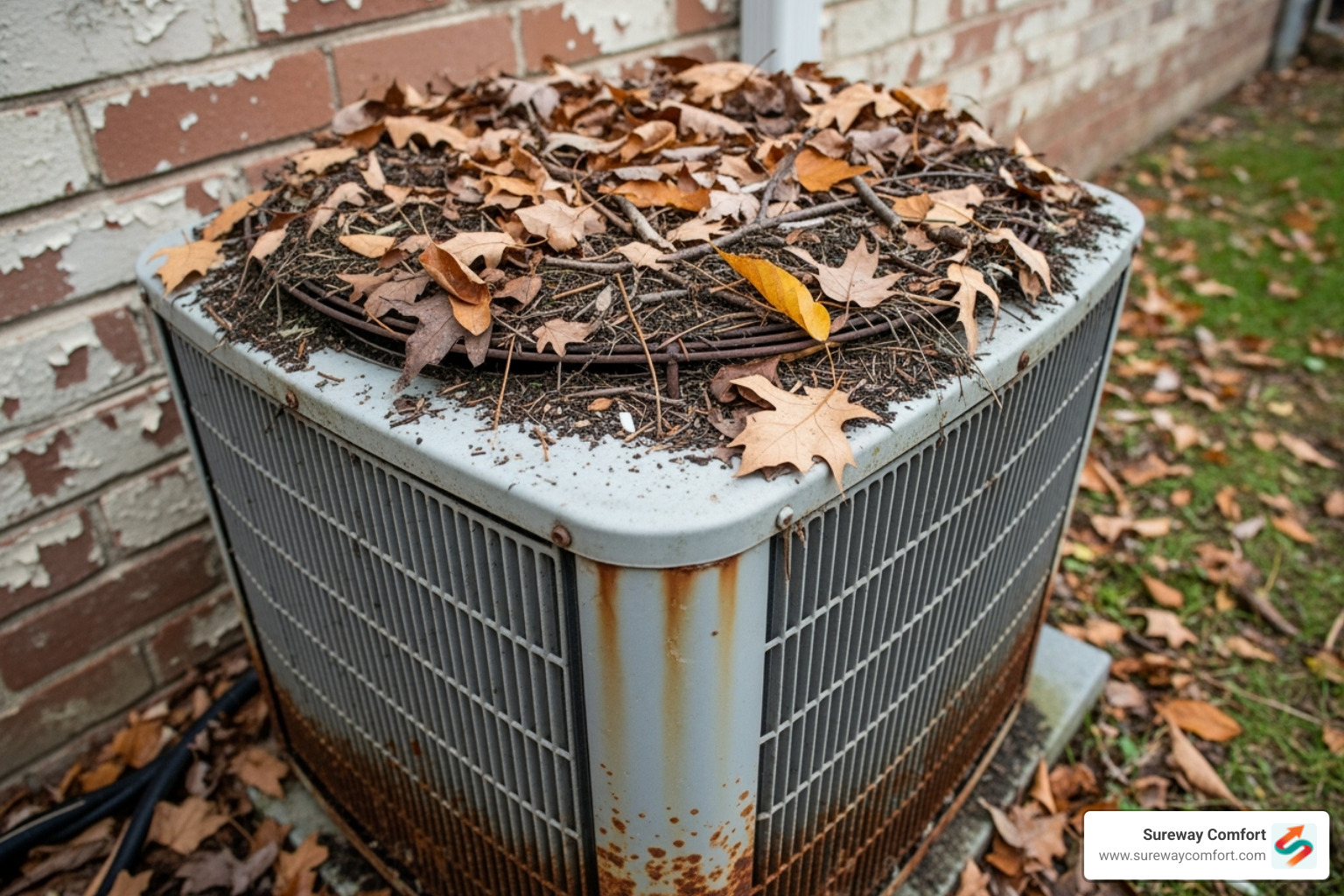
A Dirty Outdoor Condenser Unit
Your outdoor condenser unit is like the exhaust system for your AC – it's where all that unwanted heat from your home gets dumped. But here's the thing: if it's clogged up with debris, leaves, grass clippings, or just plain old dirt, it can't do its job properly. Think of trying to breathe through a dirty mask – not very effective!
When your condenser can't release heat efficiently, your entire system struggles. The unit works harder, uses more energy, and still leaves you sweating indoors. We've seen condenser units so packed with leaves they looked more like garden planters than cooling equipment!
The good news? This is often something you can tackle yourself with a little care. First, safety first – always turn off the power to your outdoor unit before you start cleaning. You'll find a disconnect switch in a small box near the unit, or you can flip the breaker at your main electrical panel.
Once the power's off, clear away any visible debris around the unit. Give yourself at least two feet of clearance on all sides – your condenser needs room to breathe! For the unit itself, a gentle spray with your garden hose can work wonders on those dirty coils. Just remember: gentle is the key word here. Skip the pressure washer, as those delicate aluminum fins can bend or damage easily.
Frozen Evaporator Coils
Picture this: it's blazing hot outside, but your indoor AC unit looks like it belongs in a winter wonderland, complete with ice and frost. While it might seem weird, frozen evaporator coils are actually a pretty common reason why your AC not cooling your home properly.
These coils live inside your indoor unit and are responsible for absorbing heat from your home's air. When they're covered in ice, they can't absorb anything – it's like trying to soak up water with a frozen sponge.
You might notice ice or frost on the copper refrigerant lines coming from your indoor unit, or you'll feel warm air blowing from your vents even though the system is running. Sometimes you'll hear unusual sounds as the system struggles to work around the ice buildup.
What causes this frosty situation? Usually it's restricted airflow – often from that dirty air filter we talked about earlier. But it can also happen due to low refrigerant levels or a malfunctioning blower fan.
If you find frozen coils, here's your game plan: turn off your AC at the thermostat and switch the fan setting to "On" if your thermostat allows it. This circulates warm indoor air over the coils to help them thaw. Be patient – this process can take 3 to 4 hours.
While you're waiting, double-check that air filter and replace it if needed. Also make sure all your vents are open and unobstructed. If the coils freeze up again after everything thaws out and you've addressed the airflow issues, it's time to call in professional help.
Low Refrigerant or a Leak
Here's something that surprises many homeowners: your AC doesn't actually "use up" refrigerant like a car uses gas. Refrigerant is supposed to circulate through your system indefinitely, absorbing heat inside your home and releasing it outside. So if your refrigerant levels are low, it means you've got a leak somewhere in the system.
Low refrigerant is sneaky – your system might still run, but it won't cool effectively. You might notice your AC struggling more on really hot days, or hear strange hissing or bubbling sounds coming from your indoor unit. Sometimes you'll see ice forming on the refrigerant lines (yes, low refrigerant can also cause freezing), or you might spot oily residue around the refrigerant lines where a leak is occurring.
Your energy bills might also start creeping up as your system works harder and harder to achieve the same cooling results.
Here's the important part: fixing a refrigerant leak is absolutely not a DIY project. Refrigerant contains chemicals that can be toxic and flammable, and handling it requires specialized equipment and EPA certification. Simply adding more refrigerant without fixing the underlying leak is like putting a band-aid on a broken pipe – it's temporary, wasteful, and harmful to the environment.
If you suspect a refrigerant issue, it's time to call in the professionals who have the proper training and tools to diagnose the leak, repair it safely, and restore your system to proper working order.
When to Call a Professional for AC Repair
We get it – there's something satisfying about fixing things yourself. But when it comes to your AC system, some problems are like trying to perform surgery with a butter knife. It's just not going to end well! Complex components, electrical systems, and refrigerant handling require specialized knowledge and tools that most homeowners simply don't have access to.
AC not cooling issues involving major components can quickly turn from a minor inconvenience into a major expense if not handled properly. That's where the expertise of professional HVAC technicians becomes invaluable. At Sureway Comfort, our experienced team has seen it all in Bridgeville, PA, and the surrounding areas like South Fayette, Upper St. Clair, Mt. Lebanon, McDonald, Scott Township, Canonsburg, and Bethel Park.
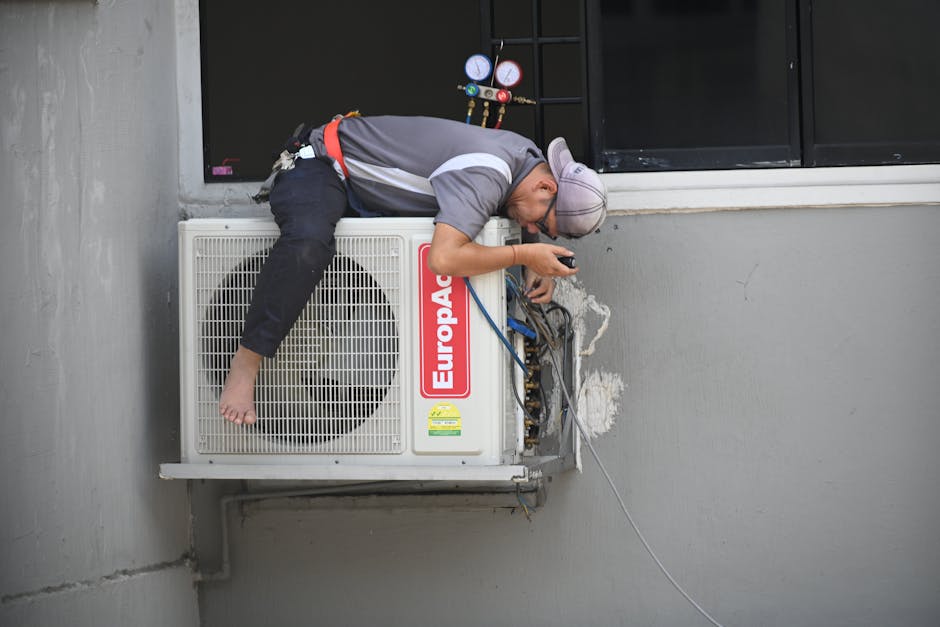
A Faulty Compressor
Think of your compressor as the heart of your AC system – it's what keeps everything pumping and working smoothly. When this crucial component starts failing, your AC not cooling becomes the least of your worries. The compressor circulates refrigerant and maintains the pressure needed for the entire cooling process.
You'll know something's wrong when your outdoor unit starts making strange grinding, humming, or rattling noises that weren't there before. Sometimes the unit will struggle to start or refuse to turn on altogether, even though you can hear the indoor fan running. Another telltale sign is when your circuit breaker keeps tripping every time the AC tries to start up.
When a compressor fails, your system simply can't absorb and transfer heat effectively. Running your AC with a failing compressor is like driving a car with a blown engine – you're just making the damage worse and more expensive. This is definitely one of those times when calling a professional isn't just recommended, prevent a complete system replacement.
Electrical Control Failures
Beyond the simple circuit breaker issues we covered earlier, your AC system has a web of electrical components that would make even an electrician pause. These intricate parts work together like a perfectly choreographed dance, and when one steps out of line, the whole performance suffers.
Capacitors are those small, cylindrical components that give your compressor and fan motors the electrical boost they need to start up. When they fail, your AC might not turn on at all, or it could run sporadically like it can't make up its mind. Contactors act like high-voltage switches, turning power on and off to your outdoor unit. If they get stuck or wear out, your system won't operate correctly.
Then there's the wiring itself. Over time, connections can become loose, wires can fray, or corrosion can set in. This leads to frequent cycling where your AC turns on and off rapidly, reduced efficiency, or complete system shutdown. More importantly, electrical problems create serious safety hazards, including potential fire risks.
If you notice your system behaving erratically or suspect electrical issues beyond a simple breaker reset, it's time to step back and contact our professional team. Working with electricity and HVAC systems requires specialized training and tools – it's simply not worth the risk.
An Undersized or Aging System
Sometimes the problem isn't that something's broken – it's that your AC system has either reached the end of its natural life or was never quite right for your home in the first place. Both scenarios can leave you wondering why your AC is not cooling effectively, even when everything seems to be running normally.
Most AC systems have a lifespan of 10 to 15 years, and like all of us, they don't age gracefully. Components wear down, efficiency naturally declines, and what once kept your home perfectly comfortable now struggles during those sweltering summer days. You might notice frequent repairs becoming the norm, energy bills creeping higher each year, or persistent cooling issues that never quite get resolved.
An undersized unit for your home's square footage will run almost constantly, desperately trying to reach a temperature it simply can't maintain. It's like asking a compact car to tow a boat – technically possible, but not pretty. On the flip side, an oversized unit will short-cycle, turning on and off too frequently, which wastes energy and wears out components faster.
Our experienced technicians can assess whether your current system is appropriately sized for your home's needs or if it's time to start fresh with a new, properly sized unit. Sometimes the most cost-effective solution is knowing when to say goodbye to an old friend and hello to reliable, efficient cooling.
Frequently Asked Questions about AC Cooling Issues
When you're dealing with an AC not cooling situation, you're definitely not alone. We get calls every day from homeowners asking the same questions you probably have right now. Let's tackle the most common ones to help you understand what's happening with your system.
Should I turn off my AC if it's not cooling?
Yes, absolutely turn it off! We know it feels counterintuitive – when you're hot, the last thing you want to do is shut off your AC. But here's the thing: continuing to run a malfunctioning system is like driving a car with a flat tire. You're only going to make things worse.
If your AC is not cooling, running it can turn a simple fix into a major headache. Let's say your evaporator coils are frozen because of a dirty filter. Keep running that system, and you could end up with serious compressor damage that requires replacing the entire outdoor unit. That's a much bigger problem than a clogged filter!
Plus, you're wasting energy and money on electricity bills without getting any comfort in return. Turn off the system, let any frozen coils thaw completely, and then start troubleshooting. Your AC (and your wallet) will thank you.
Why is my AC running but not blowing cold air?
This is probably the most frustrating situation – you can hear your AC working hard, but your home feels like a sauna. The good news is that most causes of this problem have clear solutions.
A dirty air filter is usually the culprit. When your filter is clogged with dust and debris, it's like trying to breathe through a pillow. Your system can't pull enough air across the evaporator coils to cool properly. Low refrigerant levels from a leak in the system will also prevent proper cooling, even though everything sounds like it's running normally.
Frozen evaporator coils create the same problem – ice blocks the airflow, so warm air just circulates through your home. Sometimes it's your dirty outdoor condenser unit that's the issue. If those coils are covered in leaves, grass, and dirt, they can't release heat effectively.
Don't overlook the simple stuff either. Check that your thermostat is actually set to "Cool" mode and that your vents aren't blocked by furniture or curtains. We've seen plenty of cases where a faulty compressor was running but not actually circulating refrigerant properly, or where electrical issues prevented the cooling cycle from working even though the fan was spinning.
Does cleaning the AC filter make the air colder?
Here's a question that gets to the heart of how your AC really works. Cleaning your filter won't make the air coming out of your vents any colder in terms of actual temperature. But – and this is a big but – it will make your system cool your home much more effectively.
Think of a clean filter as clearing a traffic jam on the highway. When air can flow freely through your system, it moves smoothly over those evaporator coils where the actual cooling happens. Better airflow means more effective heat absorption, which translates to your AC actually doing its job instead of struggling against restrictions.
Your system won't have to work as hard to pull air through, so it can focus its energy on cooling rather than just trying to breathe. The result? More consistent temperatures throughout your home and an AC that can actually keep up with hot summer days. So while the air temperature itself isn't directly changed by a clean filter, the overall cooling performance of your system definitely improves.
If you're still dealing with an AC not cooling after trying these troubleshooting steps, it's time to call in the professionals. Our experienced technicians at Sureway Comfort can quickly diagnose the issue and get your system back to keeping you comfortable. Contact us today for reliable AC repair in Bridgeville, PA and the surrounding areas.
Get Your Cool Back with Expert Help
There's nothing quite like that moment of relief when your AC not cooling problem finally gets solved and that first wave of cool air hits your face again. We hope the DIY checks we've covered have helped you get to the bottom of what's been making your home feel more like a sauna than a sanctuary.
Sometimes the fix really is as simple as changing a dirty air filter or adjusting your thermostat settings. Other times, you might need to clear some debris from around your outdoor unit or reset a tripped breaker. These small victories can save you time, money, and a lot of sweaty discomfort.
But let's be honest – some problems are just too complex or dangerous to tackle on your own. Refrigerant leaks, faulty compressors, and electrical issues require specialized tools, training, and safety equipment that most homeowners don't have lying around in their garage. Trying to fix these yourself can turn a manageable repair into a much bigger headache (and expense).
The secret to avoiding many of these frustrating "AC not cooling" situations in the first place? Regular maintenance. Think of it like taking your car in for an oil change – a little preventive care goes a long way toward keeping everything running smoothly when you need it most.
At Sureway Comfort, we've been helping homeowners in Bridgeville, PA and surrounding communities like South Fayette, Upper St. Clair, Mt. Lebanon, McDonald, Scott Township, Canonsburg, and Bethel Park stay cool and comfortable for years. Our experienced technicians know these systems inside and out, and we've streamlined our process to get your AC back up and running as quickly as possible.
We also offer maintenance plans designed to catch potential problems before they leave you sweating through another sleepless summer night. Because nobody should have to choose between comfort and peace of mind.
If your AC is still giving you the cold shoulder (or rather, the warm shoulder), don't suffer through another day of discomfort. Our team is ready to diagnose the problem and get your home back to that perfect, cool temperature you've been missing.




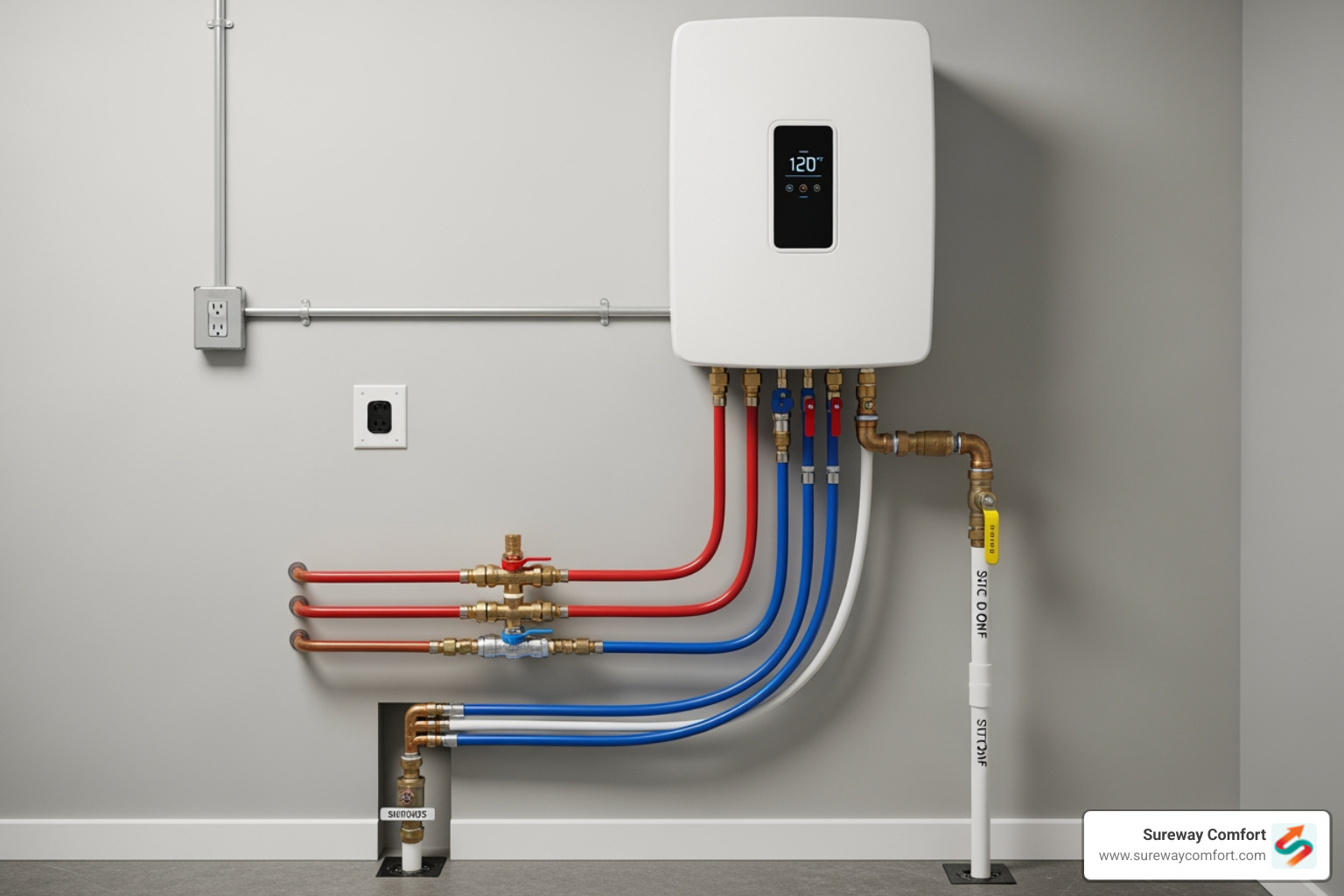

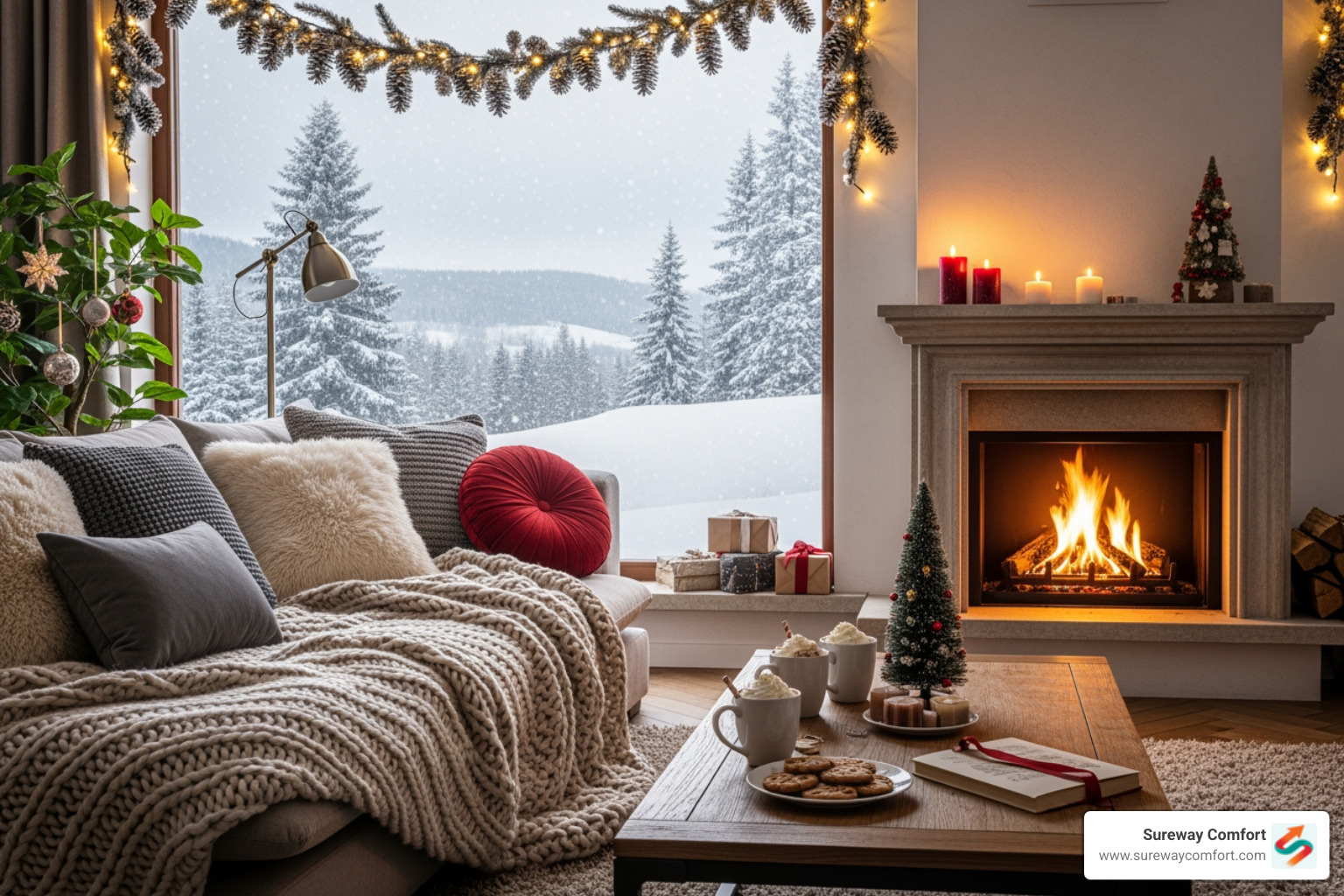





















.avif)



